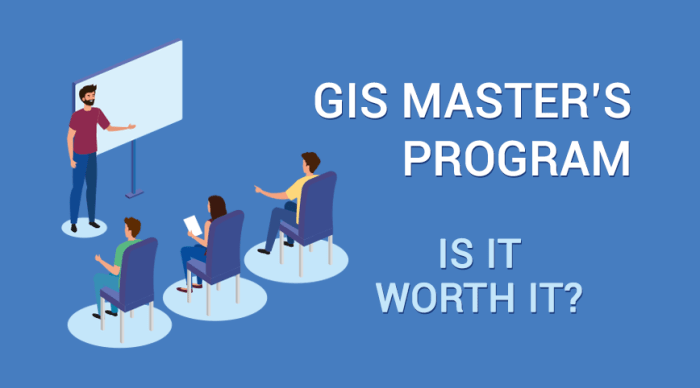gis master opens the door to a rich universe of geospatial knowledge, offering students the chance to delve deep into the complexities of geographic information systems. With an array of courses designed to equip future professionals with essential skills, these programs underscore the importance of both theoretical understanding and practical application. As the demand for GIS technology continues to rise across various sectors, pursuing a master’s degree in this field signifies a commitment to excellence and innovation.
In this exploration, we will uncover the core components of GIS master programs, compare online and on-campus options, and highlight the significance of accreditation. Additionally, we’ll delve into career opportunities, emerging technologies, and the vibrant research trends that are shaping the future of GIS.
Overview of GIS Master Programs
GIS (Geographic Information Systems) master’s programs are designed to equip students with the skills and knowledge necessary to analyze spatial data for a variety of applications, including urban planning, environmental management, and transportation logistics. These programs blend theoretical concepts with practical skills, enabling graduates to address complex issues using spatial data analysis. The curriculum generally includes both required courses and electives that allow students to tailor their education to meet specific career goals.The core components of GIS master programs typically encompass essential subjects such as Geographic Information Science, Remote Sensing, Spatial Analysis, and Cartography.
In addition to these foundational topics, students often have the opportunity to select from a range of electives that delve deeper into specialized areas, such as Geospatial Intelligence, Urban Informatics, and Environmental Modeling. This balance of core and elective courses ensures that graduates have a well-rounded education, applicable across various industries where GIS technology is utilized.
Required Courses and Electives
A thorough understanding of GIS requires a combination of theoretical learning and technical skills. The required courses usually cover fundamental concepts and methodologies essential for mastering GIS technology. Common required courses include:
- Introduction to Geographic Information Systems
- Spatial Data Analysis
- Remote Sensing Technologies
- GIS Programming and Automation
- Cartographic Design and Visualization
These courses are complemented by electives that allow students to explore niche topics in greater depth. Elective courses may include:
- Geospatial Intelligence
- Health GIS
- Transportation Systems Analysis
- Urban and Regional Planning
- Environmental Impact Assessment
This structure of core and elective courses ensures that students develop both a broad understanding of GIS as well as specialized skills relevant to their chosen field of interest.
Online vs. On-Campus GIS Master Programs
The choice between online and on-campus GIS master programs is significant for prospective students, as each format offers distinct advantages and challenges. On-campus programs typically provide a more traditional learning environment, promoting face-to-face interaction with professors and peers, which can enhance collaborative learning and networking opportunities. Students also benefit from access to specialized laboratory facilities and resources for hands-on experience with GIS software and applications.Conversely, online GIS master programs offer flexibility that appeals to working professionals or those with personal commitments.
Online students can often complete coursework at their own pace, making it easier to balance education with work and family responsibilities. However, online programs may lack the immediacy of in-person interactions and may require students to be more self-motivated in their studies.
Significance of Accreditation for GIS Master’s Degrees
Accreditation is a vital aspect for students considering a GIS master’s degree, as it ensures that the program meets established standards of education and quality. Accredited programs are recognized by employers and can enhance a graduate’s job prospects. They often adhere to rigorous academic criteria and maintain accountability for educational outcomes.There are several accrediting bodies for GIS programs, such as the Association of American Geographers (AAG) and the Accreditation Board for Engineering and Technology (ABET).
Attending an accredited program can also provide students with access to financial aid and funding opportunities that may not be available otherwise. In conclusion, the choice of a GIS master’s program should be informed by considerations of course offerings, program format, and accreditation status, as these factors significantly impact the quality and applicability of the education received.
Career Opportunities with a GIS Master

Graduates of GIS master programs are well-positioned to enter a diverse array of career paths, leveraging their specialized skills in geographic information systems. The demand for GIS professionals continues to rise across multiple sectors, underscoring the value of advanced education in this field. From urban planning to environmental management, the opportunities available are vast and varied.
Potential Career Paths for GIS Graduates
Possessing a master’s degree in GIS opens doors to numerous career opportunities. The following list Artikels prominent roles that graduates can aspire to:
- GIS Analyst: Focuses on analyzing spatial data to support decision-making in various sectors, such as environmental agencies or urban development firms.
- Cartographer: Specializes in map-making and visualization, utilizing GIS technology to create informative and accurate maps for education, research, and public use.
- Urban Planner: Integrates GIS tools to design and manage urban spaces, ensuring sustainable development and efficient land use.
- Remote Sensing Specialist: Analyzes data collected from satellite imagery and aerial photography to monitor environmental changes and land use.
- GIS Developer: Creates software applications and tools that enhance GIS functionalities, focusing on programming and database management.
- Geospatial Consultant: Provides expert advice to organizations on effective GIS practices and data management strategies.
Success Stories of GIS Professionals, Gis master
Many professionals have advanced their careers significantly after completing a GIS master program. Notable examples include:
- A former GIS Analyst who transitioned into a management role within a large environmental consulting firm, utilizing their expertise to lead large-scale projects.
- A graduate who founded a successful startup focused on developing innovative GIS applications for smart cities, significantly impacting urban planning strategies.
- A remote sensing specialist who played a pivotal role in disaster response efforts during natural calamities, leveraging GIS technology to optimize resource allocation.
Essential Skills and Tools for GIS Positions
Success in GIS-related roles requires a robust skill set and proficiency with various tools. Key competencies include:
- Spatial Analysis: Ability to analyze spatial relationships and patterns, critical for roles such as GIS Analyst and Urban Planner.
- Programming Skills: Proficiency in languages like Python or R for automating geospatial processes and analysis.
- GIS Software Expertise: Familiarity with leading GIS software such as ArcGIS, QGIS, and ERDAS Imagine, essential for map creation and spatial analysis tasks.
- Data Management: Skills in managing and organizing large datasets, particularly in relation to databases like SQL.
- Cartographic Design: Knowledge of visual design principles to create effective and aesthetically pleasing maps.
“GIS professionals are at the forefront of solving complex spatial problems that impact society, from urban design to environmental conservation.”
Technologies and Tools in GIS
Geographic Information Systems (GIS) have evolved significantly over the past few years, driven by advancements in both technology and methodology. Modern GIS integrates a variety of sophisticated software and hardware technologies that enhance data collection, analysis, and visualization. The integration of cloud computing, machine learning, and big data analytics has transformed how spatial data is managed and interpreted, enabling professionals to derive more meaningful insights from geographic information.Recent technological advancements have paved the way for innovative tools and methodologies in GIS.
Key developments include the use of drones for aerial data collection, mobile GIS applications that allow field data collection on-the-go, and advanced visualization techniques such as 3D modeling and augmented reality. These technologies not only improve spatial data accuracy and accessibility but also streamline workflows, making GIS more efficient and user-friendly.
Popular GIS Tools
A variety of GIS tools are available in the market, each with unique features tailored for specific use cases. Understanding these tools is essential for professionals looking to leverage GIS effectively in their work. The following table Artikels some of the most widely used GIS tools, their key features, and typical applications:
| GIS Tool | Features | Use Cases |
|---|---|---|
| ArcGIS | Comprehensive mapping and analysis, real-time data integration, cloud capabilities | Urban planning, environmental management, disaster response |
| QGIS | Open-source, extensive plugin support, customizable interface | Academic research, community mapping, agriculture |
| Google Earth Pro | 3D mapping, satellite imagery, data importing | Tourism, education, real estate |
| PostGIS | Spatial database extender for PostgreSQL, advanced spatial queries | Web mapping, location intelligence, data analysis |
| GeoServer | Open-source server for sharing geospatial data, supports multiple formats | Web services, data distribution, collaborative projects |
The role of open-source GIS software is crucial in both education and professional practice. These tools not only make GIS technology accessible to a broader audience but also foster innovation through collaborative development. Open-source platforms like QGIS and GeoServer encourage users to contribute and share enhancements, which can lead to more robust solutions that meet diverse needs. Educational institutions often adopt these tools to provide students with practical experience, equipping them with skills that are in high demand in the job market.
The opportunity to study abroad is often highlighted through programs like erasmus mundus , which offers scholarships for students to engage in high-quality international education. Participating in such a program not only enhances academic knowledge but also enriches cultural experiences, fostering global connections that last a lifetime.
Additionally, the cost-effectiveness of open-source tools enables organizations, particularly non-profits and small businesses, to implement GIS solutions without facing prohibitive software licensing fees.
“Open-source GIS software democratizes the use of geospatial technologies, empowering users to customize solutions to fit their specific requirements.”
For those aspiring to excel in the global marketplace, pursuing a master international marketing can be a transformative experience. This advanced degree equips students with essential skills in strategic marketing, consumer behavior, and international business practices, preparing them for impactful careers across diverse industries.
In summary, the landscape of GIS technologies and tools is diverse and rapidly evolving, characterized by a blend of proprietary and open-source offerings that cater to a wide array of applications in various industries. As GIS continues to advance, the integration of emerging technologies like artificial intelligence and the Internet of Things will undoubtedly further enhance its capabilities and influence on decision-making processes across the globe.
Research Trends in GIS
The field of Geographic Information Systems (GIS) is continuously evolving, with groundbreaking research shaping its future. As technology advances, new applications and methodologies emerge, leading to enhanced capabilities for spatial analysis and data visualization. Current research trends highlight the integration of GIS in various sectors, including environmental studies, urban planning, and collaborative projects that leverage geographic data for comprehensive insights.The impact of GIS on environmental studies and urban planning is profound, providing tools for better decision-making and management of resources.
GIS technology enables researchers and planners to visualize complex spatial relationships, analyze environmental data, and simulate future scenarios. This comprehensive understanding aids in addressing critical challenges such as climate change, urbanization, and habitat conservation.
Emerging Research Topics in GIS
Research in GIS is expanding into several key areas that reflect current societal needs and technological capabilities. Understanding these topics is crucial for advancing the field and enhancing its application in real-world scenarios. The following emerging research areas are gaining traction:
- Big Data and GIS: The integration of big data analytics with GIS is transforming how spatial data is processed and utilized. This trend focuses on managing and analyzing vast datasets from various sources, such as social media, IoT devices, and satellite imagery.
- Remote Sensing and Environmental Monitoring: With advancements in satellite technology, researchers are increasingly using remote sensing data to monitor environmental changes, such as deforestation, urban sprawl, and climate-related phenomena.
- Public Health and GIS: The COVID-19 pandemic highlighted the importance of GIS in public health. Researchers are exploring the use of spatial analysis to track disease outbreaks and assess healthcare accessibility.
- Smart Cities and Urban Analytics: GIS plays a pivotal role in the development of smart cities. Research focuses on how spatial data can optimize urban infrastructure, enhance public services, and improve sustainability.
- Participatory GIS: Engaging communities in GIS processes is gaining attention. Research in this area explores how local knowledge can inform spatial planning and decision-making.
Impact of GIS on Environmental Studies
GIS technology significantly influences environmental studies by enabling detailed spatial analyses that inform conservation efforts and policy decisions. It helps researchers assess the effects of climate change on biodiversity, land use, and ecosystem services. For instance, a study utilizing GIS to map the distribution of endangered species provided critical insights into habitat requirements and threats, allowing for targeted conservation strategies.
Furthermore, GIS facilitates environmental impact assessments (EIAs), ensuring that potential effects of proposed projects are evaluated and managed effectively.
“The integration of GIS in environmental research allows for the visualization of complex interactions within ecosystems, providing a foundation for informed decision-making.”
Collaborative Research Projects Utilizing GIS Technology
Collaborative projects that harness GIS technology demonstrate its power in addressing multifaceted issues. These projects often bring together researchers, policymakers, and communities to work towards common goals. Key examples include:
- The National Land Cover Database (NLCD): A collaborative effort involving federal, state, and local agencies, NLCD utilizes GIS to provide a comprehensive land cover dataset for the United States, supporting environmental research and policy-making.
- Community Mapping Initiatives: Various grassroots projects utilize GIS to empower local communities in mapping resources, hazards, and social needs, enabling better engagement in urban planning processes.
- Climate Adaptation Projects: Many regions are adopting GIS to assess vulnerabilities and develop adaptation strategies in response to climate change impacts, fostering collaboration among various stakeholders.
- Crisis Response and Management: GIS has proven invaluable during natural disasters. Collaborative projects often involve agencies using GIS data to coordinate emergency responses and resource allocation effectively.
Networking and Professional Development

Networking and professional development are critical components of advancing a career in Geographic Information Systems (GIS). Engaging with other professionals, joining organizations, and participating in relevant conferences can significantly enhance learning opportunities and career prospects. By actively participating in the GIS community, individuals can exchange knowledge, stay updated on industry trends, and open doors to new career pathways.
Professional Organizations and Conferences
Joining professional organizations and attending conferences provides invaluable resources for GIS practitioners. Membership often includes access to journals, webinars, and networking events. Below is a list of key organizations and notable conferences that cater to GIS professionals:
- American Society for Photogrammetry and Remote Sensing (ASPRS)
-A leading organization for professionals in photogrammetry, remote sensing, and GIS. - International Map Industry Association (IMIA)
-Focuses on the global mapping industry, fostering collaboration and knowledge-sharing among members. - Geospatial Intelligence Foundation (GIF)
-Offers professional development and networking opportunities in the geospatial sector. - Esri User Conference
-One of the largest gatherings of GIS professionals worldwide, featuring workshops and presentations from industry leaders. - Urban and Regional Information Systems Association (URISA)
-Promotes the effective use of GIS in urban and regional planning.
Effective Networking Strategies
Networking in the GIS community can lead to mentorship opportunities, job referrals, and collaborative projects. Implementing effective networking strategies can help professionals maximize their connections:
- Engage on Social Media
-Utilize platforms like LinkedIn and Twitter to follow industry leaders, join relevant groups, and participate in discussions. - Attend Workshops and Training Sessions
-Actively participating in workshops not only enhances skills but also offers chances to meet peers and experts in the field. - Volunteer for Committees or Boards
-Get involved with local or national GIS organizations to expand your network while contributing to the community. - Participate in Local Meetups
-Many cities have GIS-focused meetups where professionals share insights and experiences.
Continuing Education and Certifications
Pursuing continuing education and certifications enhances a GIS professional’s skill set and credibility. Various programs provide cutting-edge knowledge and specialized skills necessary for career advancement:
- Esri Technical Certification
-Recognizes proficiency in using Esri’s software, which is widely used in the GIS industry. - GIS Professional (GISP) Certification
-Offered by the GIS Certification Institute, this certification validates a professional’s GIS expertise and ethical standards. - GeoAcademy Courses
-Provides a variety of courses and certifications tailored to different aspects of GIS technology. - Online Learning Platforms
-Websites like Coursera and Udemy offer courses on GIS topics, allowing professionals to learn at their own pace.
“Networking and education are not just tools for career development; they are essential components that foster innovation and collaboration within the GIS field.”



